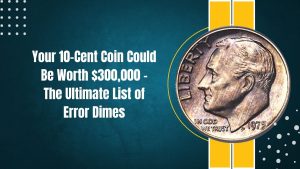Coin collecting is more than just a hobby; it’s a potential treasure hunt. Some rare coins, due to their minting errors, historical significance, or unique designs, are worth far more than their face value.
Whether you’re a seasoned collector or a curious beginner, these nine rare coins might make you a fortune. Let’s dive into their history, value, and what makes them so special.
Top 9 Most Rare Coins That Could Make You a Fortune
| Coin Name | Year | Unique Feature | Value (USD) |
|---|---|---|---|
| 1967 Kennedy Half Dollar | 1967 | Missing mint mark | Up to $6,995 |
| 1925-S Lincoln Penny | 1925 | San Francisco mint rarity | $54,625 |
| 1932-D Washington Quarter | 1932 | Bicentennial tribute | $143,750 |
| 1943-S Jefferson Nickel | 1943 | Wartime silver composition | $9,000 |
| 1909-S VDB Penny | 1909 | Designer’s initials (“VDB”) | $168,000 |
| 1983 1C Doubled Die Penny | 1983 | Doubled die reverse error | $7,050 |
| 1968 No S Roosevelt Dime | 1968 | Missing “S” mint mark | $40,250 |
| 1916 Doubled Die Buffalo Nickel | 1916 | Doubled date | $281,750 |
| 1944-D Steel Lincoln Penny | 1944 | Struck on steel planchets | $115,000 |
1. 1967 Kennedy Half Dollar
The 1967 Kennedy Half Dollar lacks a mint mark, making it unique among U.S. coins. This omission was part of a government effort to discourage hoarding. Coins in pristine condition have sold for up to $6,995 at auction.
2. 1925-S Lincoln Penny
The 1925-S Lincoln Penny from the San Francisco Mint is rare due to its low production numbers. Collectors covet this coin for its place in the wheat cent series, with some examples fetching $54,625 at auction.
3. 1932-D Washington Quarter
This quarter commemorates George Washington’s bicentennial and has become one of the most iconic U.S. coins. Its short production run has made it valuable, with auction prices reaching $143,750.
4. 1943-S Jefferson Nickel
During World War II, nickel was replaced with silver to conserve resources. The 1943-S Jefferson Nickel, with its unique composition, is a collector’s favorite, often selling for $9,000.
5. 1909-S VDB Penny
The 1909-S VDB Penny is legendary among coin collectors. Designed by Victor David Brenner, only 484,000 coins were minted with his initials before they were removed. Some specimens have sold for $168,000.
6. 1983 1C Doubled Die Reverse Penny
A doubled die stamping error on the reverse of this penny has made it a collector’s dream. Only around 5,000 coins exist, and auction prices have reached $7,050.
7. 1968 No S Roosevelt Dime
The 1968 No S Roosevelt Dime is an example of a missing mint mark error from the San Francisco Mint. Extremely rare, it can sell for as much as $40,250.
8. 1916 Doubled Die Buffalo Nickel
The 1916 Doubled Die Buffalo Nickel is a rare error coin with a doubled date, making it highly valuable. Some have sold for an astonishing $281,750.
9. 1944-D Steel Lincoln Penny
The 1944-D Steel Penny was accidentally struck on leftover steel planchets from 1943. Only about 30 coins are known to exist, with values as high as $115,000.
Tips for Identifying Valuable Coins
- Inspect for Errors: Look for signs of doubling, missing mint marks, or off-center strikes.
- Check Mint Locations: Coins from specific mints, like San Francisco or Denver, often hold higher value.
- Preserve Condition: Use airtight holders to maintain a coin’s quality and avoid damage.
The Top 9 Rare Coins showcase the extraordinary value hidden in numismatics, with some worth millions due to their rarity, history, or minting errors.
Whether you’re a collector or investor, these coins offer significant financial and historical rewards. Examine your collection—you might already possess a hidden treasure waiting to be discovered!
How do I know if my coin is valuable?
Inspect for minting errors or unique features and have your coin graded by a professional service like PCGS or NGC.
Where can I sell rare coins?
Rare coins can be sold through numismatic auctions, reputable dealers, or online marketplaces like Heritage Auctions.
Are coins with errors always more valuable?
Yes, minting errors can significantly increase a coin’s value, especially if the error is rare and well-preserved.







